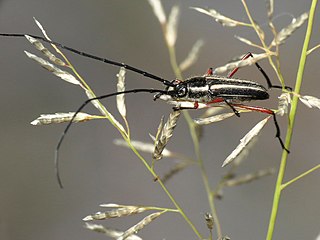Related Research Articles

John Lawrence LeConte was an American entomologist of the 19th century, responsible for naming and describing approximately half of the insect taxa known in the United States during his lifetime, including some 5,000 species of beetles. He was recognized as the foremost authority on North American beetles during his lifetime, and has been described as "the father of American beetle study."

Cortodera is a genus of beetles in the family Cerambycidae, containing the following species:

Lepturinae, the lepturine beetles, is a subfamily of the longhorn beetle family (Cerambycidae), containing about 150 genera worldwide. This lineage is most diverse in the Northern Hemisphere. Until recently the subfamily Necydalinae was included within the lepturines, but this has been recently recognized as a separate subfamily. Nine tribes are usually recognized today, with a tenth, Caraphiini, created in 2016. A few genera are of uncertain placement within the subfamily.
Brachysomida californica is the species of the Lepturinae subfamily in long-horned beetle family. It was described by John Lawrence LeConte in 1851 and is endemic to California, USA where it is found only in Santa Cruz Mountains.

Brachysomida atra is the species subfamily Lepturinae in the longhorn beetle family. It was described by John Lawrence LeConte in 1850 and is distributed in Alberta, Canada, and the United States.

Xylotrechus a genus of longhorned beetles of the family Cerambycidae, containing some 200 described species.

Sternidius is a genus of flat-faced longhorns in the family of beetles known as Cerambycidae. There are at least 20 described species in Sternidius.

Brachysomida is a genus of beetles in the family Cerambycidae, containing the following species:
Chrotoma is a genus of long-horned beetles in the family Cerambycidae. There is only one described species in Chrotoma, C. dunniana.
Zamodes obscurus is a species of beetle in the family Cerambycidae, the only species in the genus Zamodes, described by John Lawrence LeConte in 1873 from a single specimen from Pennsylvania, which remains the only specimen in existence, and the species is presumed to be extinct.

Trachyderini is a tribe of long-horned beetles in the family Cerambycidae. There are at least 140 genera and 650 described species in Trachyderini.

Moneilema armatum is a species of flat-faced longhorn in the family of beetles known as Cerambycidae. It is found in the southwestern United States and northern Mexico. The flightless beetles often feed on prickly pear cactus, boring into the stems and roots.
Dorcasina matthewsii is a species of flower longhorn in the beetle family Cerambycidae. It is found in North America and was described by John Lawrence LeConte in 1869.
Nothopleurus lobigenis, the southwestern stump borer, is a species of long-horned beetle in the family Cerambycidae. It is found in Central America and North America.
Prionus arenarius is a species of long-horned beetle in the family Cerambycidae. It is found in North America.

Parandra polita is a species of long-horned beetle in the family Cerambycidae.

Poecilium lividum is a species of long-horned beetle in the family Cerambycidae.

Sphaenothecus bilineatus, the double-banded bycid, is a species of long-horned beetle in the family Cerambycidae.

Tragosoma harrisii is a species of long-horned beetle in the family Cerambycidae.

Trichoferus campestris, the velvet longhorned beetle, is a species of long-horned beetle in the family Cerambycidae. It is native to the southeastern palearctic, from Japan through to Armenia and southeastern European Russia, and is an invasive species in North America. The velvet longhorned beetle has begun to expand its range within Europe as well, spreading west.
References
- 1 2 3 Brachysomida bivittata (Say, 1824) Biolib.cz, Retrieved 9 November 2010.
- ↑ Steven W. Lingafelter; Eugenio H. Nearns; Gérard L. Tavakilian; Miguel A. Monné; Michael Biondi (2014). Longhorned Woodboring Beetles (Coleoptera: Cerambycidae and Disteniidae). Washington, D.C.: Smithsonian Institution Scholarly Press. ISBN 978-1-935623-40-3. LCCN 2014005388.
- ↑ Yanega, Douglas (1996). Field Guide to Northeastern Longhorned Beetles. Illinois, United States: Natural History Survey. ISBN 1-882932-01-3.